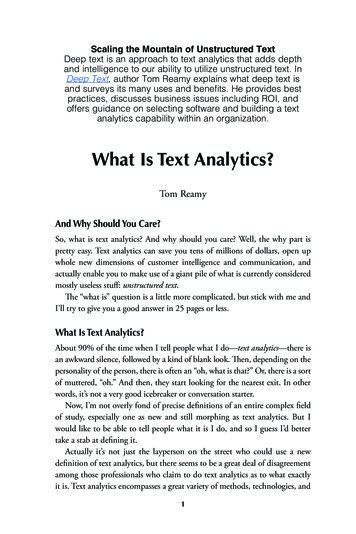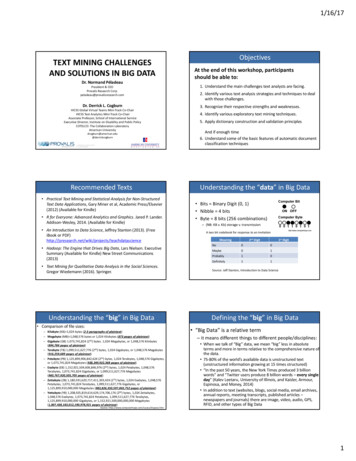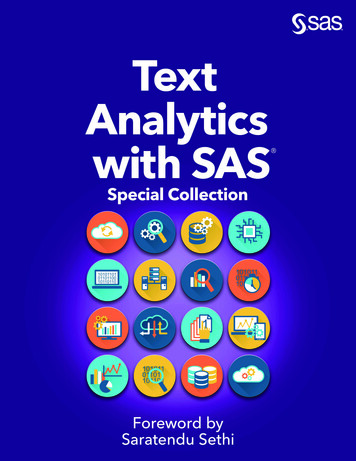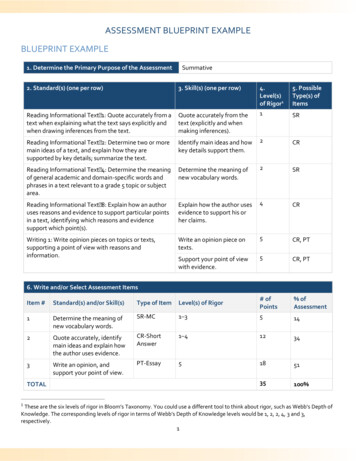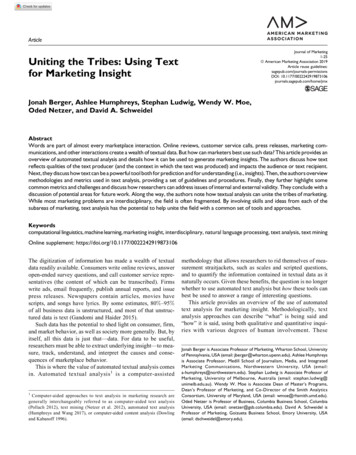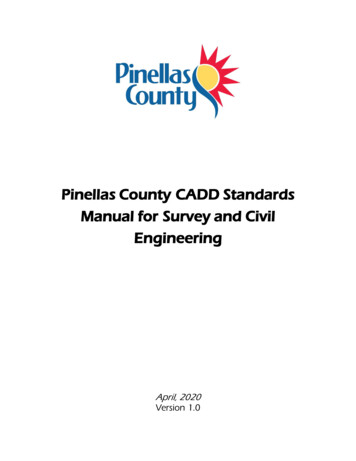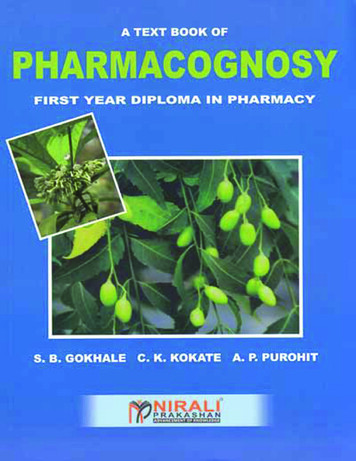
Transcription
A TEXT BOOK OFPHARMACOGNOSYFIRST YEAR DIPLOMA IN PHARMACY (As Per E. R. 1991)THIRTY-EIGHTH EDITIONS. B. GOKHALEM. Pharm., A. I. C.Former Co-ordinatorR.C. Patel Institute of Pharmaceutical Education and ResearchShirpur – 425405 (M. S.)Dr. C. K. KOKATEM. Pharm., Ph. D., F.G.A.E.S. (Germany)President,Indian Society of PharmacognosyandVice-chancellor,KLE University,JNMC Campus, Nehru Nagar,Belgaum - 590010. (Karnataka)A. P. PUROHITM. Pharm., A. I. C.Former Asst. Professor and Head,Department of Pharmacognosy,B. V.'s Poona College of Pharmacy and Research Centre,Pune - 411 038. (M.S.)Price : 265.00N1233
PHARMACOGNOSYThirty Eighth EditionReprint :::ISBN 978-81-85790-15-2July 2016March 2017AuthorsThe text of this publication, or any part thereof, should not be reproduced or transmitted in any form or stored in any computerstorage system or device for distribution including photocopy, recording, taping or information retrieval system or reproduced on anydisc, tape, perforated media or other information storage device etc., without the written permission of Authors with whom the rights arereserved. Breach of this condition is liable for legal action.Every effort has been made to avoid errors or omissions in this publication. In spite of this, errors may have crept in. Any mistake,error or discrepancy so noted and shall be brought to our notice shall be taken care of in the next edition. It is notified that neither thepublisher nor the authors or seller shall be responsible for any damage or loss of action to any one, of any kind, in any manner,therefrom.Published By :(-ve)NIRALI PRAKASHANPrinted By :YOGIRAJ PRINTERS AND BINDERSAbhyudaya Pragati, 1312, Shivaji Nagar,Off J.M. Road, Pune – 411005Tel - (020) 25512336/37/39, Fax - (020) 25511379Email : niralipune@pragationline.comSurvey No. 10/1A, Ghule Industrial EstateNanded Gaon Road,Nanded, Pune – 411041Mobile No. 9404233041/9850046517 DISTRIBUTION CENTRESNirali PrakashanNirali PrakashanNirali PrakashanPUNE: 119, Budhwar Peth, Jogeshwari Mandir Lane, Pune 411002, MaharashtraTel : (020) 2445 2044, 66022708, Fax : (020) 2445 1538Email : bookorder@pragationline.com, niralilocal@pragationline.com: S. No. 28/27, Dhyari, Near Pari Company, Pune 411041Tel : (020) 24690204 Fax : (020) 24690316Email : dhyari@pragationline.com, bookorder@pragationline.comMUMBAI: 385, S.V.P. Road, Rasdhara Co-op. Hsg. Society Ltd.,Girgaum, Mumbai 400004, MaharashtraTel : (022) 2385 6339 / 2386 9976, Fax : (022) 2386 9976Email : niralimumbai@pragationline.com DISTRIBUTION BRANCHESNirali PrakashanJALGAON: 34, V. V. Golani Market, Navi Peth, Jalgaon 425001,Maharashtra, Tel : (0257) 222 0395, Mob : 94234 91860KOLHAPURNirali Prakashan: New Mahadvar Road, Kedar Plaza, 1st Floor Opp. IDBI BankKolhapur 416 012, Maharashtra. Mob : 9850046155NAGPURPratibha Book Distributors : Above Maratha Mandir, Shop No. 3, First Floor,Rani Jhanshi Square, Sitabuldi, Nagpur 440012, MaharashtraTel : (0712) 254 7129Nirali PrakashanDELHI: 4593/21, Basement, Aggarwal Lane 15, Ansari Road, DaryaganjNear Times of India Building, New Delhi 110002. Mob : 08505972553BENGALURUPragati Book House: House No. 1, Sanjeevappa Lane, Avenue Road Cross,Opp. Rice Church, Bengaluru – 560002.Tel : (080) 64513344, 64513355,Mob : 9880582331, i Books : 9/1, Montieth Road, Behind Taas Mahal, Egmore,Chennai 600008 Tamil Nadu, Tel : (044) 6518 3535,Mob : 94440 01782 / 98450 21552 / 98805 82331,Email : bharatsavla@yahoo.comniralipune@pragationline.com www.pragationline.comAlso find us onwww.facebook.com/niralibooksNote : Every possible effort has been made to avoid errors or omissions in this book. In spite this, errors may havecrept in. Any type of error or mistake so noted, and shall be brought to our notice, shall be taken care of in the nextedition. It is notified that neither the publisher, nor the author or book seller shall be responsible for any damage or lossof action to any one of any kind, in any manner, therefrom. The reader must cross check all the facts and contents withoriginal Government notification or publications.
PREFACE TO THE THIRTY-EIGHTH EDITIONWe are pleased to release the revised Thirty-eighth edition of "Text Book ofPharmacognosy" within a span of twenty years.It is needless to say that the overwhelming response from the students andcolleagues has made this possible. In response to the constructive suggestions, wehave added few figures, index to biological names, information on isolation ofterpenoids, resins, volatile oils and glycosides as desired.We hope, we shall keep receiving the same co-operation in future as received in thepast.July 2016Authors
PREFACE TO THE FIRST EDITIONIt gives us immense pleasure in bringing out the first edition of our book inPharmacognosy for the benefit of the students of Diploma in Pharmacy.The contents of this edition have been prepared in accordance with the syllabusprescribed in New Education Regulations, 1991 of Pharmacy Council of India. Whiledescribing the crude drugs according to their pharmacological or therapeutic profiles,enough care has been taken to incorporate adequate information about their cultivation,collection and processing, as well as, chemical composition. The text has been updatedby incorporation of extra figures and chemical structures. The additional informationabout the crude drugs based on recent investigations, wherever possible, has beenincluded. Different pharmaceutical journals, scientific reviews, technical bulletins ofagencies like C.I.M.A.P., I.C.M.R., I.C.A.R. and C.S.I.R, medicinal plant abstracts andproceedings of seminars have been referred for additional information on crude drugs.The new edition is being brought out with an attractive appeal. It is hoped to be usefulfor all those who are engaged in spheres of activities pertaining to medicinal plants.We are thankful to Mr. Dineshbhai Furia and staff of NIRALI PRAKASHAN for theirefforts in bringing out this new edition in the shortest- period.S. B. GOKHALEJuly 1993C. K. KOKATEA. P. PUROHIT
SYLLABUSNumber of Lectures : 75Marks : 1001. Definition, history and scope of Pharmacognosy including indigenous system of medicine.2. Various systems of classification of drugs of natural origin.3. Adulteration and drug evaluation: Significance of Pharmacopoeial standards.4. Brief outline of occurrence distribution, outline of isolation, identification tests, therapeuticeffects and pharmaceutical applications of alkaloids, terpenoids, glycosides, volatile oils, tanninsand resins.5. Occurrence, distribution, organoleptic evaluation, chemical constituents, including testswherever applicable and therapeutic efficacy of following categories of drugs:(a) Laxatives - Aloes, rhubarb, castor oil, ispaghula, senna.(b) Cardiotonics - Digitalis, arjuna(c)Carminatives and gastro-intestinal regulators - Umbelliferous fruits: coriander, fennel,cardamom, ginger, black -pepper, asafoetida, nutmeg, cinnamon, clove.(d) Astringents - Catechu.(e) Drugs acting on nervous system - Hyoscyamus, belladonna, datura, aconite,ashwagandha, ephedra, opium, cannabis, nux vomica.(f)Antihypertensives-Rauwolfia(g) Antitussives-Vasaka, tolu balsam, tulsi(h) Antirheumatics-Guggul, moogra oil(k)Antidiabetics-Pterocarpus, gymnema(I)Diuretics-Gokhru, punernava(m) Antidysenterics-Ipecacuanha(n) Antiseptics and disinfectants-Benzoin, myrrh, neem, curcuma(o) Antimalarials-Cinchona(p) Oxytocics-Ergot(q) Vitamins-Shark liver oil, amla(r)Enzymes-Papaya, diastase, yeast.(s)Perfumes and flavours-Peppermint oil, lemon oil, orange oil,lemon grass oil, sandalwood.
(t)Pharmaceutical aids - Honey, arachis oil, starch, kaolin, pectin, olive oil, lanolin,beeswax, acacia, tragacanth, sodium alginate, agar, guar gum, gelatin.(u) Miscellaneous - Liquorice, garlic,shankhpushpi, pyrethrum, tobacco.picrorrhiza,dioscorea,linseed,shatavari,6. Collection and preparation of crude drugs for the market as examplified by Ergot,Opium, Rauwolfia, Digitalis, Senna.7. Study of source, preparation and identification of fibres used in sutures and surgicaldressings - Cotton, silk, wool and regenerated fibres.8. Gross anatomical studies of - Senna, datura, cinnamon, cinchona, fennel, clove, ginger,nux vomica and ipecacuanha.Crude drugs of animal originnCrude drugs of mineral origin Total Practical Hours : 75Marks : 1001.Identification of drugs by morphological characters.2.Physical and chemical tests for evaluation of drugs wherever applicable.3.Gross anatomical studies (t.s.) of the following drugs - Senna, datura, cinnamon,cinchona, coriander, fennel, clove, ginger, nuxvomica, ipecacuanha.4.Identification of fibres and surgical dressings.
CONTENTS1.History, Definition and Scope of Pharmacognosy1.1 – 1.42.Drugs and Pharmaceutical Aids of Natural Origin2.1 – 2.43.Classification of Natural Drugs3.1 – 3.64.Introduction to Parts of a Plant4.1 – 4.205.Scheme of Pharmacognostic Studies5.1 – 5.66.Collection and Preparation of Natural Drugs for Market6.1 – 6.47.Adulteration, Drug Evaluation and Significance ofPharmacopoeial Standards7.1 – 7.128.Chemical Nature of Natural Drugs8.1 – 8.229.Pharmacological Grouping of Natural Drugs9.1 – 9.192(A) Laxatives9.1 – 9.17(B) Cardiotonics9.18 – 9.24(C) Carminatives and Gastro-Intestinal Regulators9.25 – 9.49(D) Astringents9.50 – 9.52(E) Drugs acting on Nervous System9.53 – 9.76(F)9.77 – 9.80Antihypertensives(G) Anti-tussives9.81 – 9.85(H) Antirheumatics9.86 – 9.91(I)Antileprotics9.92 – 9.93(J)Antitumour Drugs9.94 – 9.96(K) Antidiabetics9.97 – 9.100
(L)Diuretics9.101 – 9.104(M) Antidysenterics9.105 – 9.108(N) Antiseptics and Disinfectants9.109 – 9.117(O) Antimalarials9.118 – 9.122(P) Oxytocics9.123 – 9.127(Q) Vitamins9.128 – 9.131(R) Enzymes9.132 – 9.136(S) Perfumes and Flavours9.137 – 9.147(T)9.148 – 9.175Pharmaceutical Aids(U) Miscellaneous Natural Drugs And Natural Pesticides10. Surgical Fibres, Sutures and Surgical Dressings9.176 – 9.19210.1 – 10.14APPENDICES1.Crude Drugs and Their Indian SynonymsA.1 – A.52.Glossary3.Taxonomical Classification of Crude DrugsA.14 – A.164.Placement of Natural Drugs in PharmacopoeiaA.17 – A.205.BibliographyA.21 – A.22A.6 – A.13INDICES1.Biological IndexA.23 – A.262.Synonym IndexA.27 – A.283.Subject IndexA.29 – A.324.Coloured Photographs
1HISTORY, DEFINITION ANDSCOPE OF PHARMACOGNOSYINTRODUCTIONThe substances from plants and animal sources are being used as food since antiquity.Later on, these substances were differentiated as food stuffs and therapeutic agents, as mantried to explore and utilize these natural products for treating the ailments. Thus, theirutility to remove the disorders earned them the title-drug (originally from Frenchlanguage).(a) Charak(300 BC)(b) Sushrutha(c) Hippocrates(460 - 360 BC)(d) Aristotle(384 - 322 BC)(e) Dioscordies(040 - 080 AD)(f) Galen(131 - 200 AD)Fig. 1.1 : The Great Contributors(1·1)
A Text Book of Pharmacognosy1.2History, Definition & Scope of PharmacognosyAs mentioned in Papyrus Ebers, an old document written in 1500 B.C., Egyptians wereaware of medicinal uses of several plants and animals and also about human anatomy.The great Greek physician Hippocrates (460 – 360 B.C.) known as 'Father of Medicine',dealt with anatomy and physiology of human beings. Aristotle, the renowned philosopher(384 – 322 B.C.), is well known for his studies on animal kingdom and Theophrastus(370 – 287 B.C.) for plant kingdom.Dioscorides, (040 - 080 A.D.) a Greek physician in 78 A.D. described several plants ofmedicinal importance in " De Materia Medica". It was Pliny the Eider (23 – 70 A.D.), whocompiled 37 volumes of natural history. Greek Pharmacist Galen (131 - 200 A.D.)described various methods of preparation containing active constituents of crude drugs,and even at present the branch dealing with the extraction of plant and animal drugs isknown as Galenical Pharmacy.Gradually, all the natural products, utilized by physicians were compiled together toform the 'Materia Medica' giving their detailed information. The products from plants,animals and mineral origin are the three broad classes of naturally occurring drugs.Indian history of medicinal plants is dated back to 3500 B.C. The curative properties ofplants have been mentioned in the Suktas of Rigveda and Atharvaveda. Ayurveda has alsodescribed good number of plants with their therapeutic properties. The ancient wellknown treatises in Ayurveda the Charak Samhita and Susruta Samhita are written byCharak and Susruta respectively.Definition :While studying Sarsaparilla, it was Seydler, A German scientist, who coined the termPharmacognosy in 1815 in his work entitled, "Analecta Pharmacognostica" fromcombination of two Greek words viz., Pharmakon, a drug and gignosco, to acquire theknowledge of. Further, Tschirsh made it more meaningful by restricting the term to theutilization of products from natural sources. Thus, pharmacognosy is the subject of crudedrugs obtained from the plant, animal and mineral origins. It is the objective study ofcrude drugs of the natural sources processed scientifically. The word 'crude drug' itself isself-explanatory and is used with the meaning of 'simple drug' and also as it exists in thenatural form. The crude drugs are plant or animal drugs that have undergone no otherprocesses than collection and drying.Broadly, Pharmacognosy is defined as the scientific and systematic study of structural,physical, chemical and biological characters of crude drugs along with their history,method of cultivation, collection and preparation for the market.The synthetic drugs do not fall within the scope of Pharmacognosy. With the recentdevelopments in science and technology, several chemicals, which were originally foundin plants and animals are synthesized at present. The reasons for their synthesis are eitherthe scarcity or non-availability of natural drugs in which they occur, apart from the lack ofknowledge of chemical processes required to extract them.
A Text Book of Pharmacognosy1.3History, Definition & Scope of PharmacognosyScope of Pharmacognosy :Most of the crude drugs are obtained from plants and only a small number comes fromanimal and mineral origins. Drugs obtained from plants consist of entire plants or theirparts. Ephedra and datura are entire plants, while senna leaves and pods, nux-vomicaseeds and cinchona bark are parts of plants. Crude drugs may also be obtained by simplephysical processes like drying (opium) or extracting with water (catechu, agar).Several other useful substances affecting health of animals and human beings are alsoincluded alongwith crude drugs in the study of Pharmacognosy. These substances includeallergens, antibiotics, flavouring agents, colours, pesticides, immunizing agents, vehiclesand diagnostic aids.The following are few examples of each class of crude drugs.Table 1.1 : Different Sources of ibioticsAllergensImmunizing agentsPesticidesExamplesCinnamon, digitalis, saffron, clove.Bees wax, cantharides, cod-liver oil, gelatin.Chalk, bentonite, asbestos, talc, kaolin, fuller's earth.Penicillin, streptomycin, tetracycline.Pollen grains, mold spores, feathers, websVaccines, sera, antitoxins.Pyrethrin, rotenone, nicotine.RELATIONSHIP TO ALLIED FIELDS OF STUDYEven though, pharmacognosy is a branch of science dealing with crude drugs, it isvery important to know all other indirectly related aspects of biomedicinals. Tounderstand crude drugs completely, various terms used to describe the vegetable drugs ascovered in botany and animal drugs as covered in zoology must be known to apharmacognosist. He should also possess knowledge of pharmacology in order tounderstand the actions of drugs in human body. Pharmacology, like pharmacognosy, is anoutgrowth of Materia Medica. Pharmaceutical chemistry and phytochemistry are alsoessential to understand the chemical composition of crude drugs. The art of preparing thegalenicals and the use of pharmaceutical aids are covered under the subject,pharmaceutics. Knowledge of several other subjects apart from those mentioned above isnecessary for various reasons. The knowledge of the principles of genetics, plant breedingand plant pathology is essential to understand cultivation of medicinal plants. The basicknowledge of biochemistry, chemical engineering and storage technology helps us toknow the principles of collection, preparation and preservation of crude drugs.Chemotaxonomy and biosynthesis are the fields, which ought to be understood for interrelationship of active constituents and their physiological importance to the plants andanimals. Pharmacognosy plays a very important role in the development of pure sciences,e.g. in descriptive botany, plant classification (taxonomy) and plant chemistry(phytochemistry).
A Text Book of Pharmacognosy1.4History, Definition & Scope of PharmacognosyThus, pharmacognosy is an important liaison between pharmaceutical and all relatedsubjects.TRADITIONAL INDIAN SYSTEMS OF MEDICINEAyurveda :The system of Ayurveda-Ancient Science of Life-originated in India about 3000 yearsago. It is one of the oldest systems of medicine identified exclusively with ancient Indiancivilization and dealing with both preventive and curative aspects of life. The principles ofpositive health and therapeutic measures embedded in this system relate to mental,physical, social and spiritual welfare of human beings. Ayurveda encompasses theknowledge of Kayachikitsa (Internal medicine), Kaumarbhritya (Paediatrics), Trahchikitsa(Psychological medicine), Shalakya Tantra (Otorhinolaryngology and Ophthalmology),Shalya Tantra (Surgery) Agada Tantra (Toxicology), Rasayana Tantra (Geriatrics) andVajikarana Tantra (Eugenics and Aphrodisiacs).The Pharmacopoeia of Ayurveda consists of more than 8000 recipies made of naturaldrugs derived from herbal, mineral, animal and marine sources. These are used singly orin combinations and in varied forms such as decoctions, infusions, distillates, extractedjuices, powders, pills, tablets, syrups, fermented liquids, bhasmas, medicated oils etc.SIDDHA SYSTEM OF MEDICINEThe term ' Siddha ' means achievement and ' Siddhars ' were saintly personalities,whoattained proficiency in medicine through practice of Bhakti and Yoga. This is the system ofpre-vedic period identified with Dravidian culture and it is largely therapeutic in nature.Like Ayurveda, this system believes that all objects in universe are made up of five basicelements namely, earth, water, sky, fire and air. The identification of causative factors ofdiseases is done through pulse reading, colour of body, study of voice, urine examination,status of digestive system and examination of tongue. The literature of Siddha system ismostly in Tamil.Few natural drugs used in Siddha system of medicine are :Abini: (Papaver – somniferum),Alari: (Nerium – Indicum),Ethi: (Strychnous – Nux vomica),Gomathi: (Datura – stramonium),Haikalli: (Ephorbia – nerifolia),Rotha Polam : (Aloe – barbadensis)NATUROPATHY AND YOGANaturopathy is not merely a system of treatment, but also a way of life, which is basedon laws of nature. The attention is particularly paid to eating and living habits, adoption ofpurificatory measures, use of hydrotherapy, mud packs, baths, massage etc.The system of Yoga is as old as Ayurveda. The eight components of Yoga are restraint,observance of austerity, physical postures, restraining of sense organs, breathing exercises,contemplation, meditation and samadhi. Yoga exercises have potential in improvement ofbetter circulation of oxygenated blood in the body, restraining the sense organs,
A Text Book of Pharmacognosy1.5History, Definition & Scope of Pharmacognosyimprovement of social and personal behaviour and induction of tranquility and serenity inthe mind.
2DRUGS AND PHARMACEUTICALAIDS OF NATURAL ORIGININTRODUCTIONThough, a pharmacist is responsible for the entire process of manufacturing thepharmaceutical products, isolation or extraction of active principles from crude drugs hasbecome a chemical or biochemical operation, rather than a pharmaceutical one. Drugsare rarely administered in singular form. They are essentially mixed with various types ofadditives or adjuncts or converted them into effective drugs. Thus, a pharmacist during themanufacturing process of dosage forms comes across the actual drugs and the adjunctsused alongwith them.DRUGSEtymological survey reveals that the word drug has its origin in French language andhas been derived from the word drogue, which means any substance used in preparationof medicine. However, at present the term drug includes not only the medicines, butseveral other related substances without any pharmacological action.Technically and legally the term drug as defined in India under Drugs and CosmeticsAct of 1940 reads as follows :1. All medicines for internal or external use of human beings or animals and allsubstances intended to be used for or in diagnosis, treatment, mitigation or prevention ofdisease in human beings or animals.2.Such substances, other than food, intended to affect the structure or any functionof the human body or intended to be used for the destruction of vermin or insects, which(2·1)
A Text Book Of Pharmacognosy60%OFFPublisher : Nirali PrakashanISBN : 9788185790152Author : S. B. Gokhale, Dr.C. K. Kokate, A. P. PurohitType the URL : http://www.kopykitab.com/product/20845Get this eBook
Pragati Books : 9/1, Montieth Road, Behind Taas Mahal, Egmore, Chennai 600008 Tamil Nadu, Tel : (044)

